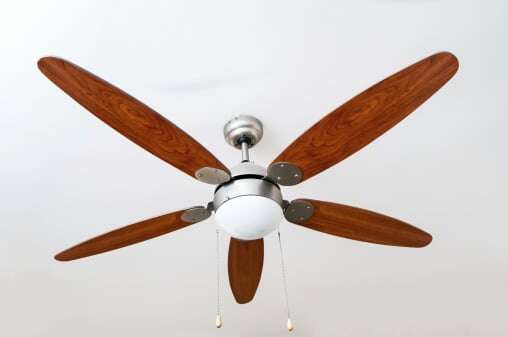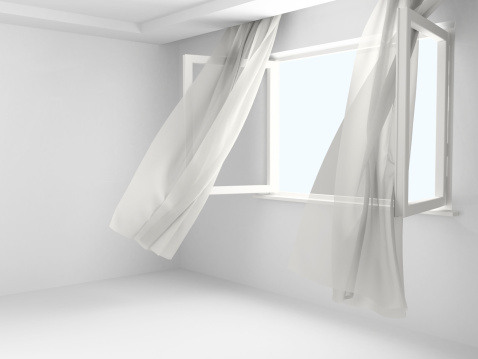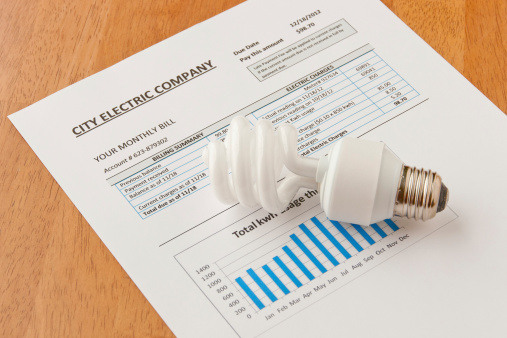 If you've ever sat below a ceiling fan and suddenly found yourself reaching for a sweater, you've experienced exactly the effect ceiling fans are intended to create. Ceiling fans circulate air to create a wind-chill effect – provided they run in a counterclockwise direction during the summer. (In the winter, they should run in a clockwise direction to push warm air down from the ceiling). But can they be substituted for your air conditioning system?
If you've ever sat below a ceiling fan and suddenly found yourself reaching for a sweater, you've experienced exactly the effect ceiling fans are intended to create. Ceiling fans circulate air to create a wind-chill effect – provided they run in a counterclockwise direction during the summer. (In the winter, they should run in a clockwise direction to push warm air down from the ceiling). But can they be substituted for your air conditioning system?
People tend to love or disdain the look of ceiling fans, but there's no denying their functionality – and their ability to help you save money on your summer energy bills. When you turn a ceiling fan to the "medium" or "high" setting and really kick up some air, you can set your thermostat about 4 degrees higher than usual, with no noticeable difference in comfort, according to the U.S. Department of Energy. And on moderately warm days when you're debating whether to turn on the air conditioner at all, you might be cool enough with only the ceiling fan running.
Many people install a ceiling fan near their kitchen, to offset the heat produced by the stove and oven. But ceiling fans also can be useful in upstairs bedrooms, where it tends to be warmer in a two-story home. No matter how many ceiling fans you have in your home or where you choose to place them, the basic science behind how they function is the same.
Ceiling fan science
Ceiling fans supply a form of ventilation, similar to when you open windows on opposite sides of your home to circulate air. While table-top and floor fans also circulate air, they can't compare to the cooling power of ceiling fans, especially when they're properly sized for a room. (And we'll help you choose the right size in a moment.)
Ceiling fans work by evaporating moisture from your skin, which makes you feel cooler on hot days. And when you feel cooler, that's when you can afford to bump up the temperature on your thermostat. These savings can add up quickly, especially with that 4-degree comfort zone; for each degree you can raise your air conditioning system thermostat setting during the summer, you can save about 1 percent on your electric bill over the course of eight hours, according to the department of energy.
Keep in mind that ceiling fans cool people, not rooms. The wind-chill effect they create will not reduce a room's temperature – not even by 1 degree – even if you feel distinctly chilly when you walk into a room where one is running. So it makes no sense to keep a ceiling fan running when nobody is home, or even when nobody is in the room.
Proper sizing matters
Ceiling fans are best suited in rooms in which the ceiling is at least 8 feet high. The blades should fall no closer than 8 inches from the ceiling – between 10 and 12 inches is ideal to ensure proper air flow – and 18 inches from the closest wall.
Ceiling fans come in multiple sizes for a practical reason. Fans that are 36 or 44 inches in diameter are designed for rooms up to 225 square feet – or 15-by-15 feet – while fans that are 50 to 54 inches in diameter are meant for larger rooms.
As you might expect, ceiling fans with larger blades move more air – and produce more cooling power – than those with smaller blades. But you don't have to overdo it – and probably shouldn't overdo it – in rooms where even a soft, constant breeze might be distracting, such as in a home office that is strewn with important papers. You also should consider the aesthetics and layout of a room. For example, a larger fan might be technically suitable for an oversized room, but it also could look overpowering if that room contains dropped ceilings or dormer windows.
As with other items you purchase for your home, it usually doesn't pay to try to save a few dollars by choosing a less expensive ceiling fan; you'll probably end up sacrificing quality. (Cheaper models also tend to be noisier.) Look for the Energy Star label on ceiling fans; they can move 20 percent more air than standard models. This is important, especially if you wish to “partner” the fan with your air conditioning system this summer.
For help in choosing the right ceiling fan (or fans) for your home, call Experts In Your Home. We'll help you capitalize on the potential for energy efficiency – with or without a sweater in tow.
When's the last time you maintained your air conditioning system?








